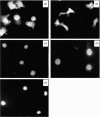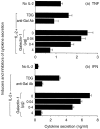Specific inhibition of T-cell adhesion to extracellular matrix and proinflammatory cytokine secretion by human recombinant galectin-1
- PMID: 10447720
- PMCID: PMC2326819
- DOI: 10.1046/j.1365-2567.1999.00746.x
Specific inhibition of T-cell adhesion to extracellular matrix and proinflammatory cytokine secretion by human recombinant galectin-1
Abstract
The migration of immune cells through the extracellular matrix (ECM) towards inflammatory sites is co-ordinated by receptors recognizing ECM glycoproteins, chemokines and proinflammatory cytokines. In this context, galectins are secreted to the extracellular milieu, where they recognize poly-N-acetyllactosamine chains on major ECM glycoproteins, such as fibronectin and laminin. We investigated the possibility that galectin-1 could modulate the adhesion of human T cells to ECM and ECM components. T cells were purified from human blood, activated with interleukin-2 (IL-2), labelled, and incubated further with intact immobilized ECM and ECM glycoproteins in the presence of increasing concentrations of human recombinant galectin-1, or its more stable, related, C2-S molecule obtained by site-directed mutagenesis. The presence of galectin-1 was shown to inhibit T-cell adhesion to intact ECM, laminin and fibronectin, and to a lesser extent to collagen type IV, in a dose-dependent manner. This effect was specifically blocked by anti-galectin-1 antibody and was dependent on the lectin's carbohydrate-binding properties. The inhibition of T-cell adhesion by galectin-1 correlates with the ability of this molecule to block the re-organization of the activated cell's actin cytoskeleton. Furthermore, tumour necrosis factor-alpha (TNF-alpha) and interferon-gamma (IFN-gamma) production was markedly reduced when IL-2-activated T cells were incubated with galectin-1 or its mutant. This effect was prevented by beta-galactoside-related sugars. The present study reveals an alternative inhibitory mechanism for explaining the suppressive properties of the galectin-1 subfamily on inflammatory and autoimmune processes.
Figures



Similar articles
-
IL-2 induces T cell adherence to extracellular matrix: inhibition of adherence and migration by IL-2 peptides generated by leukocyte elastase.J Immunol. 1998 Sep 1;161(5):2465-72. J Immunol. 1998. PMID: 9725245
-
Induction of mast cell interactions with blood vessel wall components by direct contact with intact T cells or T cell membranes in vitro.Clin Exp Allergy. 2004 Nov;34(11):1725-31. doi: 10.1111/j.1365-2222.2004.02093.x. Clin Exp Allergy. 2004. PMID: 15544597
-
Galectin 1 modulates attachment, spreading and migration of cultured vascular smooth muscle cells via interactions with cellular receptors and components of extracellular matrix.J Vasc Res. 1999 Jan-Feb;36(1):47-58. doi: 10.1159/000025625. J Vasc Res. 1999. PMID: 10050073
-
Galectin interactions with extracellular matrix and effects on cellular function.Methods Enzymol. 2006;417:247-56. doi: 10.1016/S0076-6879(06)17017-2. Methods Enzymol. 2006. PMID: 17132509 Review.
-
T lymphocyte migration: the influence of interactions via adhesion molecules, the T cell receptor, and cytokines.Crit Rev Immunol. 1995;15(3-4):285-316. doi: 10.1615/critrevimmunol.v15.i3-4.60. Crit Rev Immunol. 1995. PMID: 8834453 Review.
Cited by
-
Low-dose cyclophosphamide modulates galectin-1 expression and function in an experimental rat lymphoma model.Cancer Immunol Immunother. 2007 Feb;56(2):237-48. doi: 10.1007/s00262-006-0176-0. Epub 2006 May 30. Cancer Immunol Immunother. 2007. PMID: 16733672 Free PMC article.
-
The potential immunomodulatory role of human milk oligosaccharides in prevention of viral infections and development of asthma in early life.Front Immunol. 2025 Jun 25;16:1572787. doi: 10.3389/fimmu.2025.1572787. eCollection 2025. Front Immunol. 2025. PMID: 40636105 Free PMC article. Review.
-
Regulation of cellular homeostasis by galectins.Glycoconj J. 2002;19(7-9):507-15. doi: 10.1023/B:GLYC.0000014080.95829.52. Glycoconj J. 2002. PMID: 14758074 Review.
-
Protective effects of the galectin-1 protein on in vivo and in vitro models of ocular inflammation.Mol Vis. 2015 Sep 2;21:1036-50. eCollection 2015. Mol Vis. 2015. PMID: 26392742 Free PMC article.
-
Towards molecular mechanisms regulating the expression of galectins in cancer cells under microenvironmental stress conditions.Cell Mol Life Sci. 2015 Nov;72(22):4327-40. doi: 10.1007/s00018-015-2008-x. Epub 2015 Aug 6. Cell Mol Life Sci. 2015. PMID: 26245305 Free PMC article. Review.
References
-
- Barondes SH, Cooper DNW, Gitt MA, Leffler H. Galectins: structure and function of a large family of animal lectins. J Biol Chem. 1994;269:20807. - PubMed
-
- Barondes SH, Castronovo V, Cooper DNW, et al. Galectin: a family of animal β-galactoside-binding lectins. Cell. 1994;76:597. - PubMed
-
- Kasai K, Hirabayashi J. Galectins: a family of animal lectins that decipher glycocodes. J Biochem. 1996;119:1. - PubMed
-
- Hirabayashi J, Kasai K. The family of metazoan metal-independent β-galactoside-binding lectins: structure, function and molecular evolution. Glycobiology. 1993;3:297. - PubMed
-
- Poirrier F, Robertson EJ. Normal development of mice carrying a null mutation in the gene encoding the L-14 S-type lectin. Development. 1993;119:1229. - PubMed
Publication types
MeSH terms
Substances
LinkOut - more resources
Full Text Sources
Other Literature Sources
Research Materials
Miscellaneous

